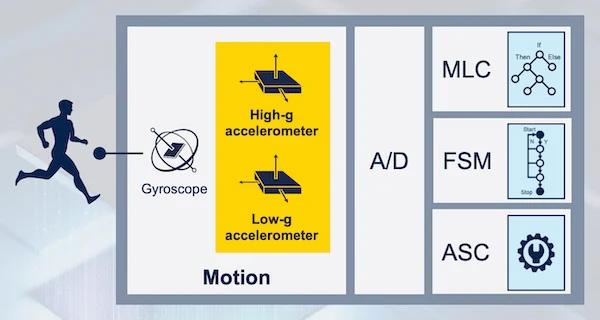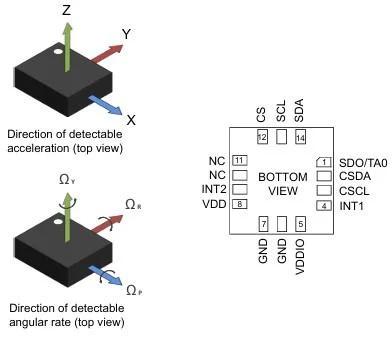
ST Intros ‘All-in-One’ MEMS Sensor Targeting Wearable Impact Sensing
STMicroelectronics recently added the LSM6DSV80X multi-mode accelerometer to its MEMS portfolio. The new part combines 16 g and 80 g accelerometer structures with a 4,000-degree-per-second (dps) gyroscope and embedded intelligence. ST says the dual-scale accelerometer capability senses light movement and intense impacts without compromising either end of sensitivity.

Dual-range six-axis intelligent IMU.
ST designed the part using two accelerometers to compensate for the range limitations of MEMS devices. High-g accelerometers generally can’t function in the less-than-10-g environment, and low-g units struggle to get beyond 30 gs. By putting two in the same package and adding intelligence to manage the transition, one part can cover a broad range with great accuracy.
Many designers will include a second discrete accelerometer part to cover the g range that the primary IMU does not well cover. Alternately, other designers will create a product that has a limited range and thus less universal application ability. ST claims its single-chip solution addresses a wide variety of wearable and sports monitoring applications. With the new part, a single IMU can cover both the high- and low-g ends of the spectrum.
The Basics of the New Multi-Mode Accelerometer
ST's new IMU comes in a compact 2.5 mm x 3 mm x 0.8 3mm 14-pin LGA package. It provides a six-axis reading of angular rates and acceleration with two acceleration scales. Ultra-low power consumption—as low as 0.67 mA—adds power life and flexibility for wearable products.

Six independent axes and component footprint.
The LSM6DSV80X accelerometer includes a dedicated and independent gyroscope, low-g and high-g accelerometer channels, and data processing. Other notable specifications include:
- Smart FIFO up to 4.5 KB
- Dual accelerometer channels
- Low-g channel ±2/±4/±8/±16 g full scale
- High-g channel ±32/±64/±80 g full scale
- Gyroscope
- ±250/±500/±1,000/±2,000/±4,000 dps full scale
- SPI/I²C and MIPI I3C v1.1 serial interface with main processor data synchronization
- Analog supply voltage of 1.71 V to 3.6 V
- Independent I/O supply (extended voltage range: 1.08 V to 3.6 V)
- Supply current
- Six-axis configuration at 0.67 mA in combo high-performance mode
- Nine-axis configuration at 0.80 mA in combo high-performance mode
Measuring Basic Movements to Sports Training
Human activity is actually full of movement extremes, from subtle motions to intense shocks. While activity-tracking devices may easily measure walking, gestures, and position changes, the subtlety of these movements may fall below the threshold of many accelerometers. On the other side of the coin, a fast run or high-intensity sport like basketball can involve shocks of 75 gs or more.
The LSM6DSV80X accommodates this broad range by including a low-g accelerometer for up to 16 g and a high-g accelerometer for up to 80 g. The chip automatically switches between the two to continuously read from 2 g up to 80 g. The 2 g-to-16 g accelerometer is used for wake-up functionality and active low-g sensing.
The continuous range makes the device a flexible IMU for a wide variety of wearable and sports-tracking devices. It is equally suited to applications as mild as a pedometer or as critical as a smart shoe impact sensor.
The IMU's Integrated Intelligence and Special Features
The IMU has integrated processing capabilities to enable preprocessing and internal sensor fusion. The processing core includes a machine learning core (MLC) and finite state machine (FSM), which provide independent action/reaction capability without external processor intervention. Adaptive self-configuration (ASC) recognizes different activity scenarios and adapts the component operation accordingly. A 4.5 KB data FIFO supports batch mode collecting and real-time sensing capability. Batch mode gives the product designer more flexibility by not requiring constant connection or communications with a host CPU.

LSM6DSV80X internal architecture.
The MLC delivers edge artificial intelligence (AI) functionality by learning from past actions to help with automated configuration and the adaptive measuring process. The FSM allows easy part configuration with low internal overhead, and the ASC utilizes data from both to configure the part for current and future settings. Self-configuration reduces the need to cover all possible usage scenarios in firmware. It also reduces the need for state processing and configuration in the host processor.
A Tiny Package for Wearables of Any Size
ST designed the new LSM6DSV80X for a variety of wearable products measuring fitness and competitive activities. As a compact single-chip IMU solution, it can be integrated into ever-smaller devices. Combined with a microcontroller, power source, and wireless connectivity, a complete monitoring product can occupy the volume of a coin cell battery. Such functionality in a minuscule package can be built into shoes, gloves, clothing, and other sporting equipment.




